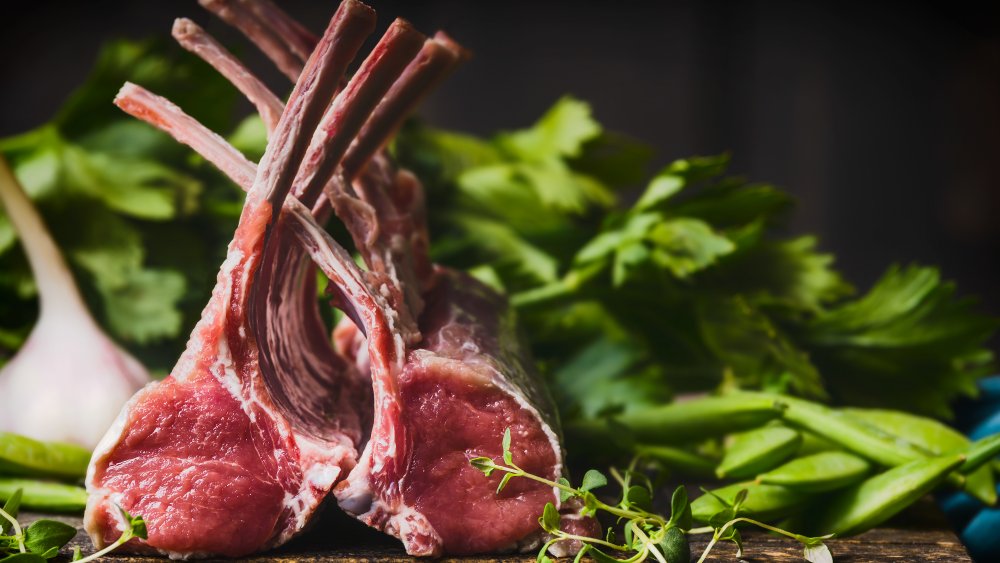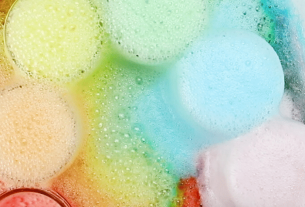Can you resist the temptation of sinking your teeth into a succulent, juicy piece of lamb cooked to perfection?
The thought of indulging in such a feast is enough to make your mouth water.
But here’s the burning question: can you eat lamb rare?
Today, we unravel the secrets behind enjoying this delectable meat while ensuring you stay safe from lurking bacteria.
So, prepare to tantalize your taste buds and satisfy your curiosity as we delve into the world of rare lamb.
can you eat lamb rare
Yes, you can eat lamb rare as long as the exterior is cooked and the surface bacteria is killed off.
It is recommended to use a meat thermometer to check for doneness, aiming for an internal temperature of 120-125 degrees Fahrenheit (50 degrees Celsius).
After cooking, letting the lamb rest for five minutes will allow it to reach a final internal temperature of 128-130 degrees Fahrenheit.
However, it is not advisable to eat rare lamb leftovers due to potential bacteria picked up during storage.
Leftover lamb should be reheated to at least medium doneness to reduce the risk of consuming harmful bacteria.
Eating raw lamb is generally not recommended, but small exceptions can be made for high-quality, previously frozen lamb when preparing lamb tartare.
It is important to ensure cleanliness and follow proper food safety guidelines to minimize the risk of foodborne illnesses associated with undercooked lamb.
Key Points:
- Lamb can be eaten rare if the exterior is cooked and surface bacteria is killed off.
- A meat thermometer can be used to check for doneness, with a target internal temperature of 120-125 degrees Fahrenheit.
- Allowing cooked lamb to rest for five minutes can increase its internal temperature to 128-130 degrees Fahrenheit.
- Leftover lamb should not be eaten rare, as it may contain bacteria acquired during storage.
- Leftover lamb should be reheated to at least medium doneness to reduce the risk of consuming harmful bacteria.
- Raw lamb is generally not recommended, but exceptions can be made for high-quality, previously frozen lamb when making lamb tartare.
can you eat lamb rare – Watch Video


Pro Tips:
1. Contrary to popular belief, lamb can be eaten rare, just like beef. However, it is important to ensure that the meat has been properly handled and sourced from a reputable supplier to minimize any potential health risks.
2. The term “rare” refers to the doneness or cooking level of the meat. In relation to lamb, it means that the meat is quickly seared on the outside, leaving the inside tender and pink, with an internal temperature of around 125°F (51.6°C).
3. Lamb that is cooked rare tends to have a more delicate and succulent texture, with a fuller flavor profile compared to well-done lamb, which can become tough and lose some of its natural juiciness.
4. The preference for eating lamb rare is more common in certain cuisines, such as Mediterranean and Middle Eastern, where dishes like shawarma, kebabs, and grilled chops are often served slightly pink in the middle.
5. Professional chefs and food enthusiasts often encourage experimenting with different lamb cooking methods and doneness levels to fully appreciate the diverse taste and texture profiles of this versatile meat.
Eating Rare Lamb: Surface Bacteria And Cooking Precautions
Lamb, known for its tender and flavorful meat, can be enjoyed rare when proper precautions are taken to ensure food safety. When cooking lamb rare, it is crucial to understand that the exterior must be adequately cooked to eliminate surface bacteria. This means that while the center may remain pink and juicy, the surface should be cooked thoroughly to ensure any potential bacteria is killed off.
It is recommended to use a meat thermometer to check for doneness. When cooking lamb rare, aim for an internal temperature of 120-125 degrees Fahrenheit (50 degrees Celsius). This temperature range ensures that any harmful bacteria present in the meat are killed off, providing a safe and enjoyable dining experience. By paying careful attention to the cooking process, the risk of foodborne illnesses can be significantly reduced.
Meat Thermometer: The Key To Safely Enjoying Rare Lamb
To ensure the safe consumption of rare lamb, it is essential to use a meat thermometer. This handy tool allows you to monitor the internal temperature of the meat accurately. When cooking lamb, it is best to insert the thermometer into the thickest part of the meat, avoiding any bones or fat. By doing so, you can accurately measure the temperature and determine the doneness of the lamb.
For rare lamb, aim for an internal temperature of 120-125 degrees Fahrenheit (50 degrees Celsius). This temperature is a critical factor in ensuring that any harmful bacteria present in the meat are destroyed. By relying on a meat thermometer, you can have peace of mind knowing that your lamb is safe to eat rare, while still being cooked to the optimum temperature.
- Use a meat thermometer to monitor the internal temperature of the lamb.
- Insert the thermometer into the thickest part of the meat, avoiding bones or fat.
- Aim for an internal temperature of 120-125 degrees Fahrenheit (50 degrees Celsius) for rare lamb.
“To ensure the safe consumption of rare lamb, it is essential to use a meat thermometer.”
Letting Lamb Rest: Achieving The Perfect Internal Temperature
Once you have cooked the lamb to the desired rareness and it has reached an internal temperature of 120-125 degrees Fahrenheit (50 degrees Celsius), it is important to let the lamb rest before serving. During this resting period, the lamb continues to cook from residual heat. It allows the internal temperature to rise slightly, reaching a final safe temperature of 128-130 degrees Fahrenheit (53-54 degrees Celsius).
Letting the lamb rest for approximately five minutes allows the juices to redistribute, resulting in a more tender and flavorful meat. This resting period also ensures that the lamb reaches a safe internal temperature, eliminating any remaining risk of consuming undercooked meat. By giving the lamb the time it needs to rest, you can achieve the perfect balance between rareness and overall doneness.
- Cook lamb to desired rareness and internal temperature of 120-125°F (50°C)
- Let lamb rest to continue cooking and reach final safe temperature of 128-130°F (53-54°C)
- Resting for approximately five minutes allows juices to redistribute for tender and flavorful meat
Beware Of Leftovers: Risks Of Consuming Rare Lamb The Next Day
While it is possible to enjoy rare lamb when freshly cooked, it is not recommended to consume rare lamb leftovers. The reason behind this precaution lies in the potential for bacteria growth during the storage period. When lamb is not cooked to at least medium doneness, there is a higher chance of harmful bacteria surviving and multiplying.
To avoid any risks associated with consuming rare lamb leftovers, it is crucial to either discard them or ensure they are thoroughly reheated. Bacteria such as E. Coli, Salmonella, Staphylococcus aureus, Norovirus, and Campylobacter are commonly associated with undercooked meat and can pose significant health risks if not handled properly. Therefore, it is best to err on the side of caution and dispose of any rare lamb leftovers.
- Rare lamb should not be consumed as leftovers due to bacteria growth.
- Thoroughly reheat rare lamb leftovers to eliminate any potential bacteria.
- Discard any rare lamb leftovers to avoid health risks.
Reheating Leftovers: Ensuring Safety Through Proper Doneness
If you must consume lamb leftovers, proper reheating is essential to reduce the chances of consuming harmful bacteria. Leftover lamb should be reheated to at least medium doneness, with an internal temperature of 145 degrees Fahrenheit (63 degrees Celsius). This ensures that any potential bacteria present in the leftovers are effectively eliminated, providing a safer meal.
When reheating lamb, it is advisable to use a meat thermometer to check the internal temperature. This simple step ensures that the meat reaches the recommended temperature for safe consumption. By reheating the lamb to at least medium doneness, you can minimize the risk of foodborne illnesses and enjoy your leftovers with peace of mind.
Raw Lamb And Food Safety Concerns: An Unconventional Choice
While eating rare lamb is an acceptable choice for many meat enthusiasts, consuming raw lamb is not advisable due to food safety concerns. Raw lamb carries a higher risk of containing harmful bacteria, including those associated with undercooked meat. These bacteria can cause severe illness if ingested, leading to symptoms such as stomach cramps, diarrhea, vomiting, and in some cases, even hospitalization.
Despite the potential risks, some people enjoy lamb tartare, a dish made from finely chopped or minced raw lamb. If you choose to make lamb tartare, it is crucial to:
- Use only high-quality, previously frozen lamb. Freezing the meat helps kill off potential parasites that may be present.
- Ensure strict cleanliness during the preparation process to minimize the risk of contamination and foodborne illnesses.
Remember to prioritize food safety when preparing and consuming raw lamb.
Making Lamb Tartare: Quality And Cleanliness Are Paramount
If you decide to indulge in the culinary delight of lamb tartare, it is imperative to prioritize quality and cleanliness. Here are some important guidelines to follow:
- Source high-quality lamb from a reputable supplier. Ensure that the lamb has been properly frozen, as freezing helps reduce the risk of parasites.
- Choose a reliable source to ensure that the lamb is safe for raw consumption. This is crucial for minimizing any potential health risks.
- Pay close attention to cleanliness when preparing the lamb tartare. Thoroughly clean all work surfaces, utensils, and hands to minimize the risk of cross-contamination.
- Wash all ingredients used, including herbs and spices, to ensure they are free from any potential pathogens.
-
Remember to always prioritize food safety to enjoy your lamb tartare without any concerns.
-
Prioritize quality and cleanliness when indulging in lamb tartare
- Source high-quality lamb from a reputable supplier
- Ensure that the lamb has been properly frozen to reduce the risk of parasites
- Choose a reliable source to ensure the lamb’s safety for raw consumption
- Thoroughly clean all work surfaces, utensils, and hands to minimize cross-contamination
- Wash all ingredients used, including herbs and spices, to remove potential pathogens
Foodborne Pathogens: Potential Risks Associated With Undercooked Lamb
When consuming undercooked lamb, there is a potential risk of exposure to various foodborne pathogens. Common bacterial culprits include E. Coli, Salmonella, Staphylococcus aureus, Norovirus, and Campylobacter. These pathogens can cause a wide range of symptoms, from mild stomach discomfort to severe gastrointestinal distress.
Symptoms of foodborne illnesses associated with undercooked lamb include diarrhea, abdominal pain, vomiting, fever, and in some cases, bloody stools. Individuals with compromised immune systems, pregnant women, young children, and the elderly are particularly susceptible to these pathogens and should exercise additional caution when consuming undercooked lamb.
Searing For Safety: Eliminating Bacteria From The Outer Surface
One technique that can help reduce the risk of consuming harmful bacteria when eating rare lamb is searing. Searing refers to the process of quickly cooking the outer surface of the meat at high heat. This method helps kill off surface bacteria and reduces the risk of contamination, particularly when enjoying undercooked or rare lamb.
When searing lamb, make sure to achieve a crisp and brown exterior, as this indicates that the surface bacteria has been effectively eliminated. Properly searing the lamb not only enhances its flavor but also ensures a safer dining experience. By embracing the searing technique, you can further reduce the risk of foodborne illnesses associated with undercooked lamb.
- Searing lamb quickly at high heat kills off surface bacteria.
- Crisp and brown exterior indicates effective elimination of bacteria.
- Searing enhances flavor and improves safety.
- Reduces risk of foodborne illnesses from undercooked lamb.
“Searing lamb is a technique that effectively eliminates surface bacteria and reduces the risk of contamination when enjoying undercooked or rare lamb.”
Conclusion: Enjoying Rare Lamb With Caution And Attention To Food Safety Guidelines
In conclusion, lamb can be safely enjoyed rare when proper precautions are taken to ensure food safety. By cooking the exterior thoroughly, using a meat thermometer to achieve the ideal internal temperature, and allowing the lamb to rest, you can achieve a perfect balance between rareness and safety. However, it is important to be cautious with leftovers, ensuring they are properly reheated or discarded to prevent the growth of harmful bacteria.
While rare lamb can be enjoyed, consuming raw lamb is not advisable due to food safety concerns. If you choose to make lamb tartare, it is crucial to prioritize quality, using previously frozen lamb and maintaining strict cleanliness during the preparation process. Additionally, searing the lamb helps eliminate bacteria from the outer surface, further reducing the risk of foodborne illnesses.
Ultimately, by understanding and following food safety guidelines, you can enjoy the unique taste and texture of rare lamb while minimizing the risks associated with undercooked meat. Always prioritize caution, cleanliness, and the use of a meat thermometer to ensure a safe and satisfying dining experience.

You may need to know these questions about can you eat lamb rare
Is it OK to eat medium rare lamb?
Absolutely, it is perfectly safe and even preferred by many to eat medium rare lamb. It is worth noting that lamb is typically cooked rare, unless it is a braised shank. When cooked to a temperature of 140°F, lamb is considered safe to consume, although many people opt for a slightly more rare preparation that still maintains its safety.
Is lamb OK to eat pink?
Yes, it is generally safe to eat lamb that is pink as long as it is a rare lamb chop that has been properly seared. The heat from the searing process is sufficient to eliminate any bacteria present on the outer surface. However, caution should be exercised when dealing with minced or diced lamb or mutton, as it should never be served pink. It is crucial to thoroughly cook and brown minced or diced lamb to ensure the elimination of any potential bacteria. This guideline also applies to burgers made from lamb.
Can you eat raw lamb?
Raw lamb is not recommended for consumption due to the potential presence of harmful bacteria like Salmonella. Additionally, there is the risk that the sheep might be infected with diseases that can be transmitted through raw meat. However, when lamb is cooked to a rare level of doneness, it can be considered safe to eat, ensuring the elimination of bacteria and minimizing the risk of disease transmission. Therefore, it is crucial to cook lamb properly to ensure its safety for consumption.
Is it safe to eat cooked lamb?
Yes, it is safe to eat cooked lamb as long as proper food safety guidelines are followed. Cooked lamb should be consumed within 2 hours (1 hour if the air temperature is above 90 °F) or refrigerated at 40 °F or below in covered containers. It can be safely eaten within 3 to 4 days, either cold or reheated to 165 °F. For long-term storage, cooked lamb dishes can also be frozen and should be used within 2 to 3 months for best quality. By following these guidelines, you can enjoy safely cooked lamb without any concerns.
Reference source
https://truorganicbeef.com/blogs/beef-wiki/can-you-eat-lamb-rare
https://www.quora.com/Can-you-eat-lamb-cooked-rare
https://www.bbc.com/news/health-45938808
https://articles.pickme.sg/can-you-eat-raw-mutton-and-lamb/



